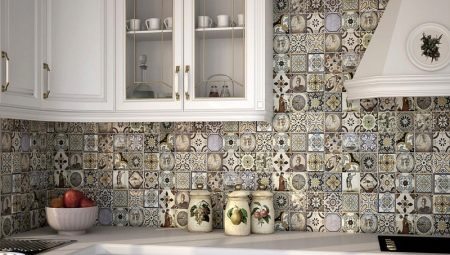No one can argue that the kitchen becomes smart when decorated with a kitchen apron. At the same time, the choice of facing material can be the most diverse. In the article, we will talk about tiles as one of the most relevant options for wall cladding in the kitchen working area today.
Pros and Cons of Using
The tiled apron brings a special touch to the interior design. Moreover, the material itself has many advantages.
- Tiles on a kitchen apron are aesthetically attractive and, if correctly selected, increase the status of the interior by an order of magnitude.
- It is distinguished by a wide range of color solutions, due to which it is convenient to select it to a specific background of the interior composition.
- Based on the design and print features, the material can be selected for any stylistic decision of the interior.
- The material has a different shape and, depending on this, provides for a different type of styling, which makes the apron special.
- The material is characterized by a wide range of price decisions, so anyone can buy it.
- Tiles differ in composition and appearance, which is why the way of facing is different. It is variable in size, so it can be laid out with special compositions.
- Most of the tiled range for laying an apron is resistant to mechanical damage, inert to mold and mildew, and also durable.
- In stores, it is serial and steam room, which allows you to choose the material with the finish, without worrying about the mismatch of colors.
- Elements can have the most diverse texture, up to imitation of the necessary material.
- The owner of the house himself can do the laying of tiles, this is not difficult, although it requires accuracy and perseverance.
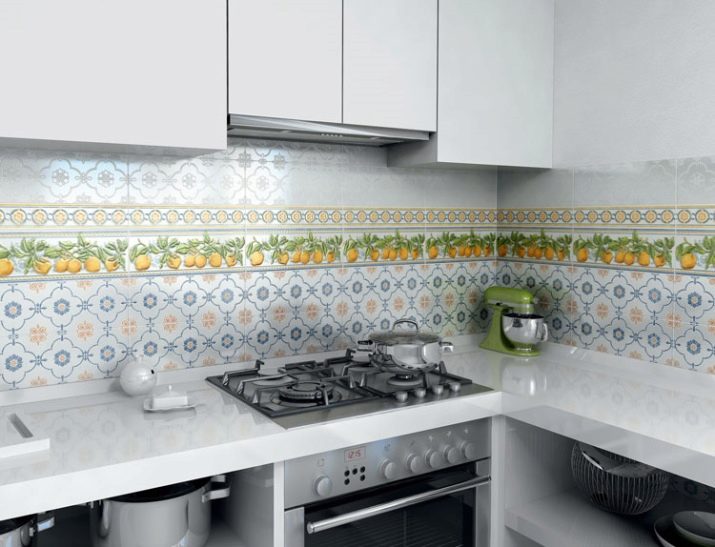

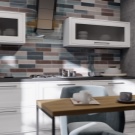
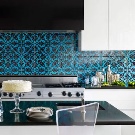
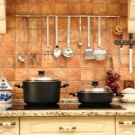
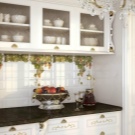
However, along with the advantages of tiled aprons, there are also disadvantages.
- When working with tiles, you will not be able to avoid dirt and building dust.
- Any departure from ideal marking will give the apron untidiness.
- Facing most of the materials will require the dismantling of part of the wall, and for better coupling, you will have to drill holes in the wall.
- For facing, you will need profiles, as well as a tile cutter, because it will have to be trimmed as necessary.
- Before laying, you will have to spend a lot of time to calculate the material consumption and the design of the apron.
- The main part of the assortment before laying is afraid of mechanical damage, and therefore the elements during transportation are often split.
- Seams are the weak point of tile aprons. It is often because of them that the apron loses its aesthetic appeal.
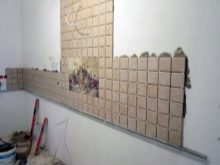
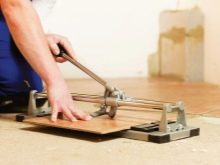
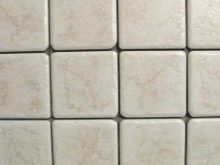
Materials
In the manufacture of tile lining for the kitchen, manufacturers use different raw materials. At the same time, the choice of a priority option will be based on the resources of a particular style that is embodied in the kitchen. For example, someone likes majolica, resistant to aggressive environment. Others like terraliawhich is made from the best grades of clay, sand and flux.
Someone uses gres or ceramic granite to clad the working area of the kitchen. Others like it more clinker (clinker tile), characterized by high aesthetic appeal. There is also a cotto or so-called Tuscan stone, which is produced from clay from the Mediterranean and parts of Central America.
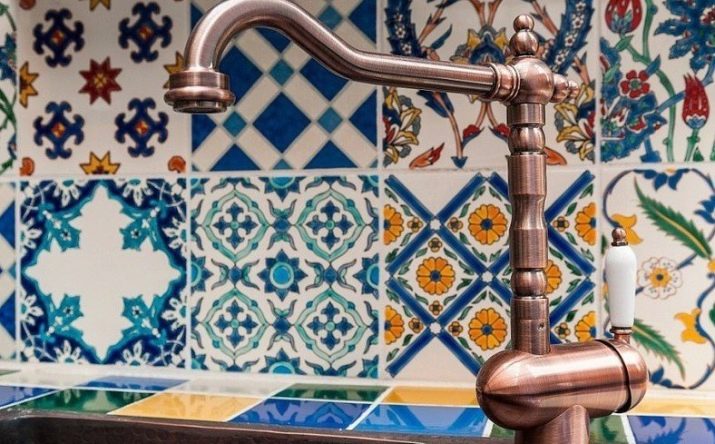
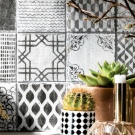
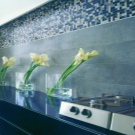
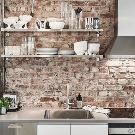
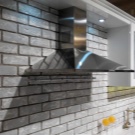

Conventionally, all varieties of material can be divided into several main groups. Tiles for a kitchen apron are:
- ceramic;
- glass;
- mosaic;
- mirrored;
- stone;
- self-adhesive.
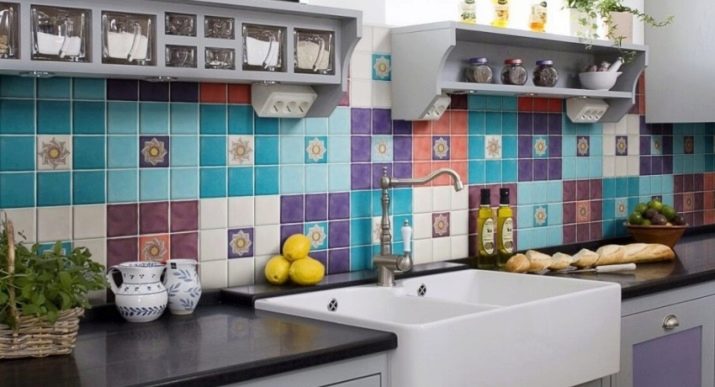
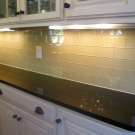
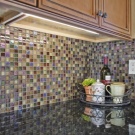
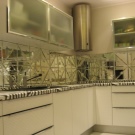
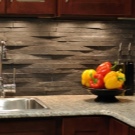
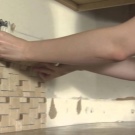
Each type of material has its own characteristics, and therefore differs in operational characteristics. Ceramic is a familiar type of material that is most often used for wall cladding. It is made from a charge mass, which includes kaolin, sand, quartz, mica and mineral oxides. It is often decorated with a beautiful pattern or ornament, it can imitate the texture of the necessary material, it can be smooth and embossed.
The tile may be extruded and extruded. It is either pressed with subsequent firing, or pressed through special equipment with further cutting and firing of the resulting formation. It has a smaller thickness compared to floor cladding.
The disadvantage of the material is the need for calibration.
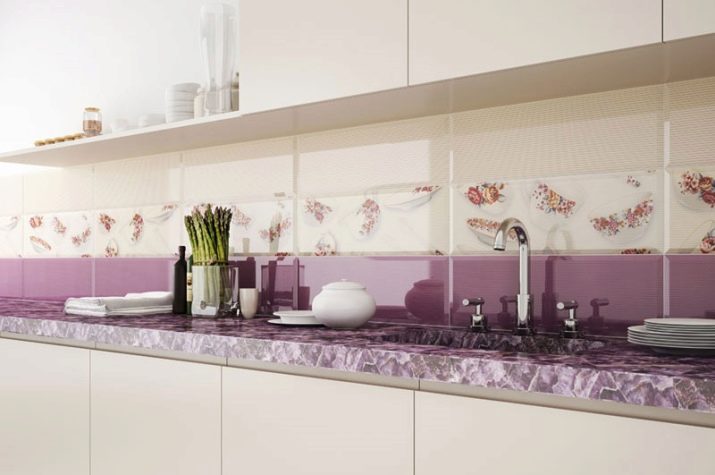
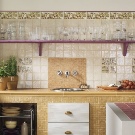
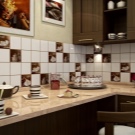

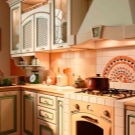
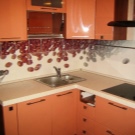
Mosaic tiles are nothing more than small squares of identical size. Gluing them to the wall has to be especially meticulous, because even a 1 mm gap can hopelessly spoil the overall appearance of the finished apron. This material is often used to accentuate an apron, laying out certain murals and sketches from the mosaic. Knowing this, the brands have developed a kind of mosaic on the grid.
This type of raw material is unique in that it already has a concrete picture of different tiles laid out and divided into separate blocks. No need to torment and create a picture, like assembling puzzles. It is glued with composite blocks, like a standard tile.
However, the location calculation must be done very carefully, otherwise the picture may visually skew.
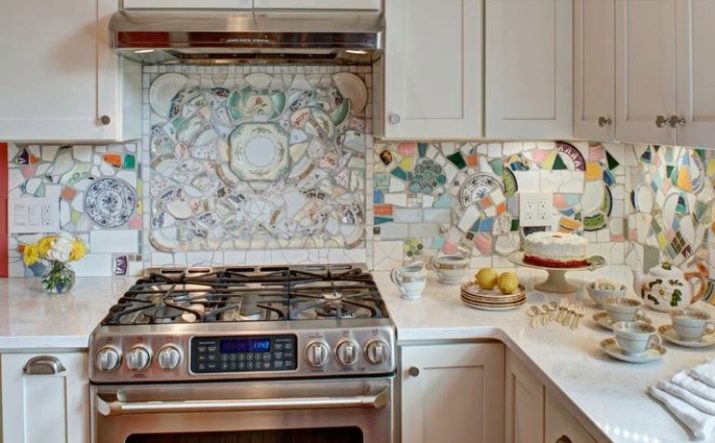
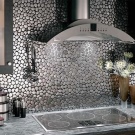

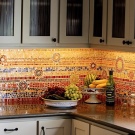
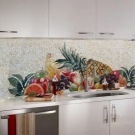
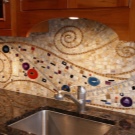
Glass tile differs from ceramic in composition. Despite its fragility, it is quite practical in everyday life, it does not absorb odors, does not burn, and is easy to clean. In addition, it is aesthetically attractive and has the ability to visually increase the space, which is typical for glass. In contrast, the mirror can not boast of aesthetic appeal in the process of long-term operation.Over time, dark spots appear on its surface.
Self-adhesive tiles are an alternative to the well-known types of tile cladding for kitchens. In fact, these are PVC tiles with different types of textures, which are glued to the prepared base. This cladding can reproduce the texture of ceramics, stone and even marble. However, if this material is easy to install, it can not be called practical.
He is afraid of high temperature, not at all environmentally friendly, short-lived.
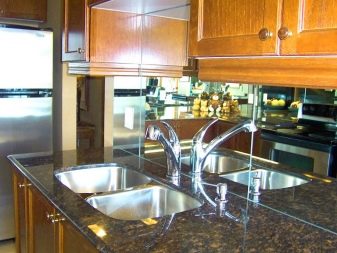
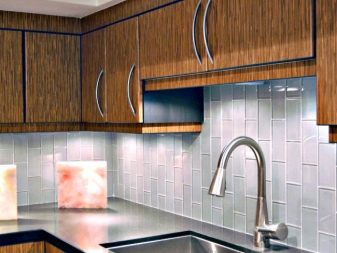
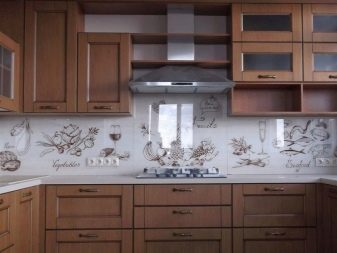
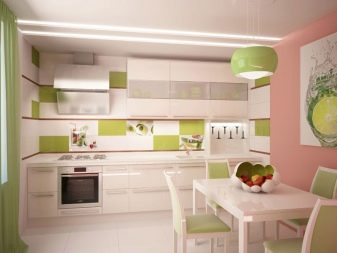
Shapes and sizes
The shape of the facing material may be different. Depending on the variety of tiles on the apron of the kitchen may be square, rectangular, rhomboid, hexagon. This allows you to diversify the styling methods, saving the working space of the kitchen from everyday life and boredom. If desired, unusual solutions can be found in stores: such a tile has not only straight and straight lines, but wavy edges.
Other details when laying form a pattern of scales, which even with a simple monophonic color looks very stylish and impressive.
By the way, even from rhombuses you can make a unique pattern by creating an apron with three-dimensional effect using elements of different colors.
Even a square tile with wavy edges looks very beautiful in the interior. Hexagon tiles can be either symmetrical or elongated, which also looks extraordinary and expressive in the interior.
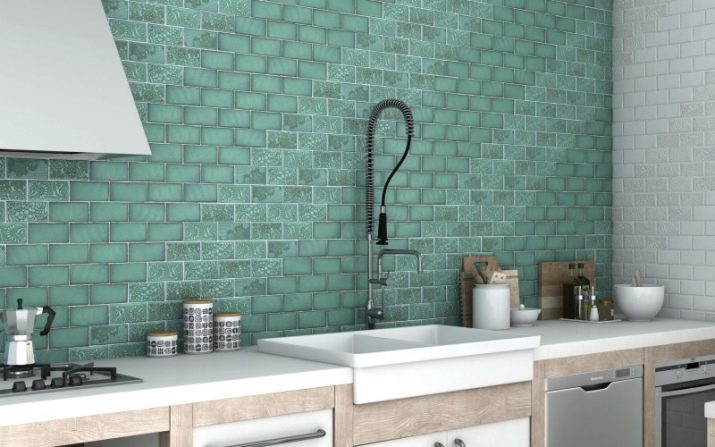
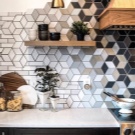
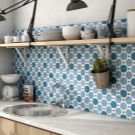
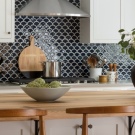
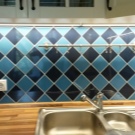

As for the dimensions of the facing material, they depend on the type of raw material and its shape, and therefore are small and large. For example, standard size ceramics are 10x10 cm. This size is convenient from the point of view of installation, as it reduces the amount of trim needed. In addition, on sale you can find tiles with convenient for laying dimensions of 15x15 cm.
Also typical sizes of square tiles are dimensions 20x20, 20x25 and 30x30 cm. In the line of points of sale you can buy items with dimensions 20x30, 30x40 cm. If we talk about the size of the mosaic for the background or the panel, the edge of its square varies in the range of 2-5 cm. Tile-boar can have different sizes. The small details of this material are 6.5x12, 7.5x15, larger analogues are 10x20, 10x25, 15x45 cm.

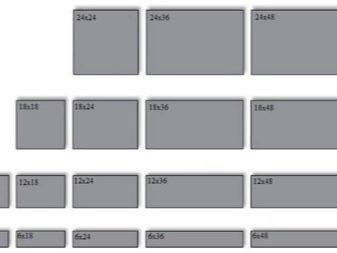
We take into account the style
In order for the apron from the tile to correspond to a certain interior style, you need to select the material correctly.
It is important to consider that cladding of any style has its own priorities in the choice of texture, size, color and shape.
In one case, symmetry and strict geometry are important, in the other the emphasis is on the eccentricity and curvature of the lines. In addition, you will have to look at the texture at the same time.
A striking example of emphasizing the oriental style is Moroccan tiles or elements with a characteristic stylistic pattern. Regardless of its color, it immediately creates a special flavor in the room. These are characteristic patterns, concrete tones, variegation of the picture. This tile in the interior of the Moroccan style looks bright and appropriate. However, it is not suitable for other styles, because they need to create a different atmosphere.
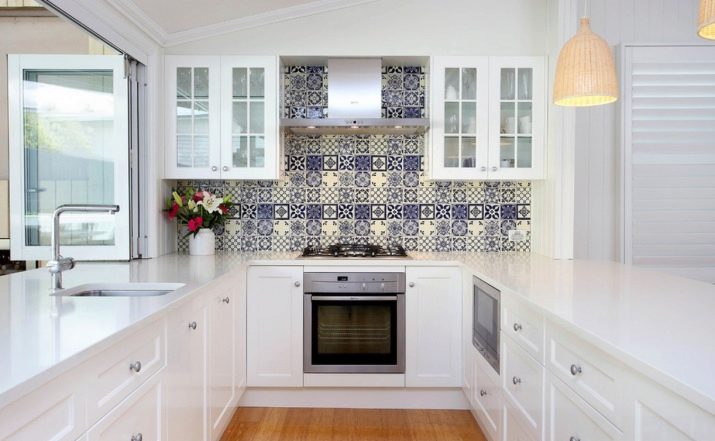
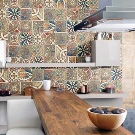
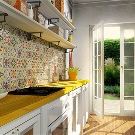
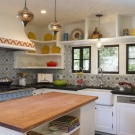
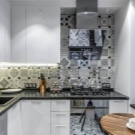
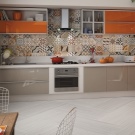
When the tiles are selected for decoration of a loft style kitchen, the situation is different. It is undesirable to take something complicated here, since it is important to create an atmosphere of an industrial facility. In view of this, the tile should be as simple as possible. For example, it can be an option in the form of ordinary square details of white color with a glossy type of front surface.
If you want something else, it makes sense to use the main resources of the style, choosing a design for concrete or brickwork.
At the same time, the color of the tile lining can be either white, or the usual brick or gray. The texture should be as close as possible to natural materials (rough surface type, dullness, small relief). Nothing bright is needed here, since it will move away from the typical atmosphere of style.
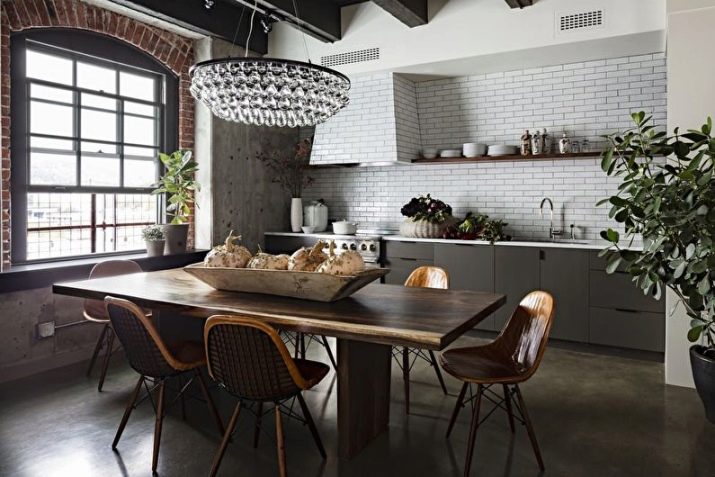
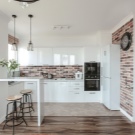
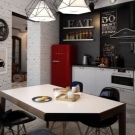
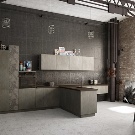
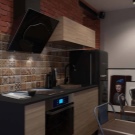
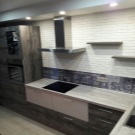
The cuisine of Provence style or the so-called French country is characterized by a tendency to cool shades of pastel colors. In this case, the priority is white. If there is little textile in the design, you can decorate the apron with not just a symbolic pattern, but a decorative panel. To place the facing composition is more appropriate over the stove.
Motives of prints should correspond to the style: these are meadow flowers, cockerels, hens, pheasants, vintage still lifes, possibly sunflowers, cornflowers. The panel can be framed in a frame from a thin border, decorated with a simple floral pattern. In this case, the tile is matched with a serial pair, in which colors and specific compositions are selected. Its size should be small, their shape is often square.
With the right approach, you can decorate the apron with mosaic tiles. However, it should be borne in mind that it will have to be dosed: here it is only relevant as a panel. The main background must be made plain monochromatic, with a frosted, possibly convex texture. At the same time, tones must be selected in such a way that they are combined with the color scheme of the kitchen interior. The colors for the traditional country are warmer, the rest of the rules for choosing tiles are the same.
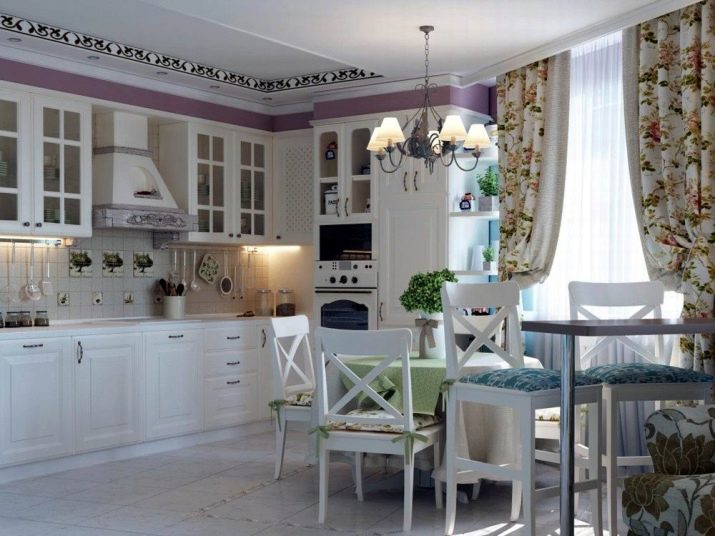
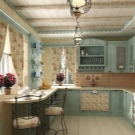


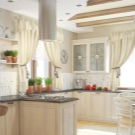
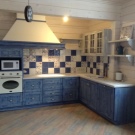
If you need to choose a tile for an apron of modern style, you need to build on the textures used in the interior. At the same time, the look of the specific design and area of the kitchen is of great importance. For example, if this is minimalism, which is embodied in a small room, the tile is selected without a pattern with a glossy surface. To visually enlarge the room and give it air, when choosing a color, preference is given to light elements.
Reflectivity and gloss - priorities for the choice of modern apron material. It is important to show the uniqueness and modernity of the cladding. The bet is not on the print, but the texture of the material. This is tile or glass, as well as mirror mosaic. It is necessary to select one or another option taking into account the lines to which stylistics strives.
For example, symmetry, color purity, uniformity of cladding, the presence of gilding and stucco decoration are important for classical cuisine. The classic style apron accent can be located in the center of the cladding. Depending on customer preferences, you can choose tile with print. This can be ornate monograms, an original beaten geometric pattern, as well as an accent in the form of a small panel, complemented by mosaic tiles. The masonry can be either traditional or diagonal.
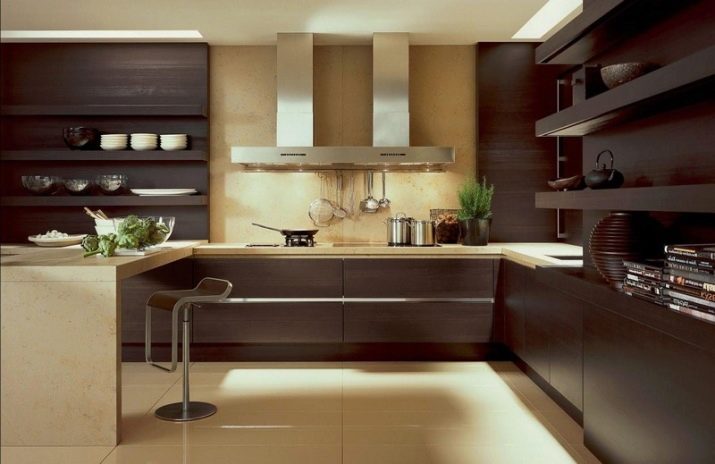
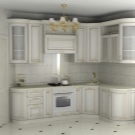
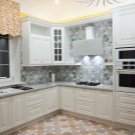
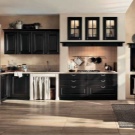
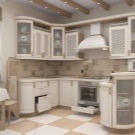
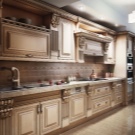
As for mosaics, this material requires a particularly careful approach to selection. If you approach the design of such an apron carelessly, instead of a stylish accent in the kitchen, you will get an attempt to create bathroom panels.
Ideally, it is better to take the option of a modular type with an already finished pattern, glue to the base which you need in blocks on the principle of ordinary masonry.
Do not mix mosaic with mosaic, because it looks, to put it mildly, not very beautiful.
Options for finishing an apron can be very diverse. Looks beautiful in the interior of the kitchen tiles under wood, stone, brick, concrete, plaster, mirror, metal. Some people prefer details with ornament, flowers, vegetation, geometric pattern. If you want to take just a mosaic, you should bet not on colorfulness and cheerful contrast, but on texture. For example, it can be material for metal or a mirror. Such a mosaic will decorate a kitchen apron in the interior of any modern style.
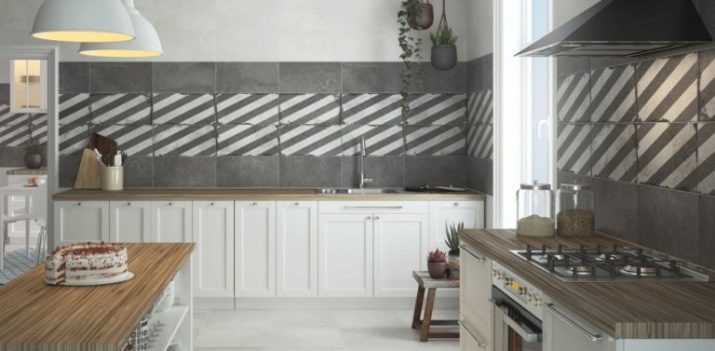
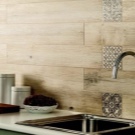

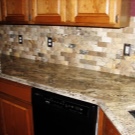

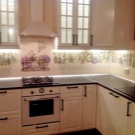
Color spectrum
The choice of colors for modern tile material is unlimited. Modern brands offer customers the widest selection of shades for every taste. However, before giving preference to one or another option, it is necessary to consider the side on which the windows face. For example, if you go north, you should not take cold tones: visually they will add an unpleasant atmosphere to the room.
However, cool tones are needed in a kitchen with windows facing south.
Tile with ornament usually has no more than 3-4 shades. At the same time, they are usually muffled, soft, which allows the colors to successfully fit into the tone of the general concept of stylistics. For example, depending on the style, this may be the color:
- gzhel with a combination of white, blue and bright blue;
- white with gray for the Scandinavian style;
- patchwork made in a combination of yellow with blue and orange;
- Moroccan tiles in contrast of beige, turquoise and brown;
- country in the form of a trio of white, beige and brick;
- Morocco combining gray, swamp and mustard tones;
- classic in a duet of white with dark wine.
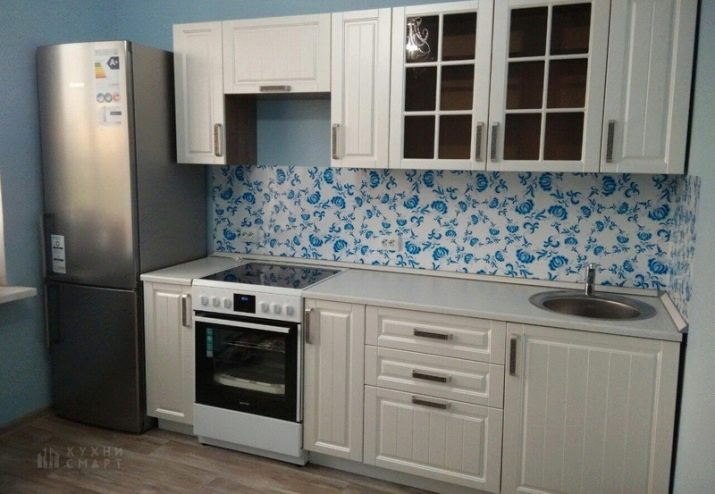
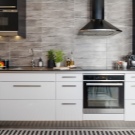
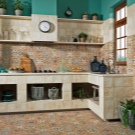
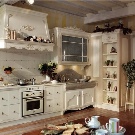
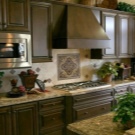
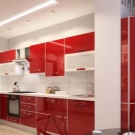
Looks good contrast beige with gray, white with silver, white with yellow and gray, mustard and gray, blue, terracotta and turquoise. If the tile with a pattern is not suitable for the interior of a particular kitchen, bet on the color of the grout. It is she who can play the role of contrast, bringing a special touch to the interior. For example, the same yellow apron can be made special by adding gray grout.
In this case, the lines will be emphasized, due to which a certain pattern will be created. In this case, the tile can be selected, for example, in the form of honeycombs, rhombuses, as well as components of hexagons. Brickwork can also be made unique by designating it with a trowel of a contrasting color and choosing related shades of the same color for laying the apron. (for example, gray with different temperature and degree of saturation).
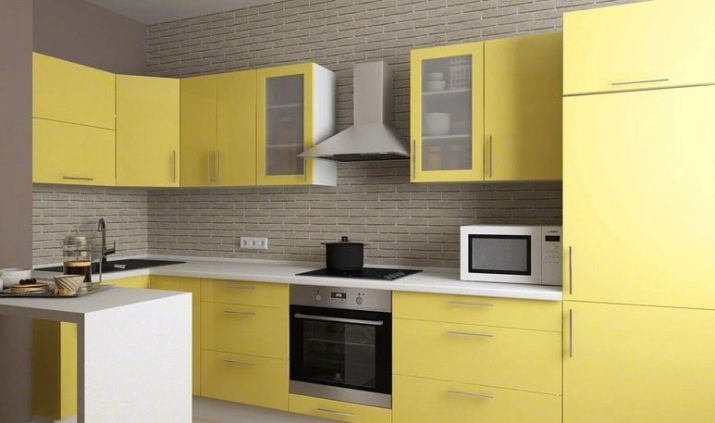
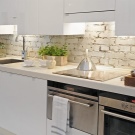
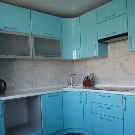
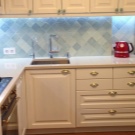
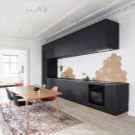

Multi-colored tiles are usually used in contrast with plain facades of hanging drawers and floor cabinets. Otherwise, it loses expression. If you decide to create a dynamic atmosphere in the kitchen, you can pay attention to the bright colors of the elements. For example, orange, lemon, green, yellow color looks beautiful in the kitchen. If you want more bold decisions, choose a wine tone in combination with a gray contrast.
Too dark and cold colors for kitchens are chosen infrequently, like a duet of white and black. So that they do not bear a negative color, they are dosed and diluted with a light companion (for example, white). Dark gray also needs a softening contrast, which is why it is usually diluted with white or light beige. If this is a mirror mosaic, it will look great against the background of a pistachio-colored headset.

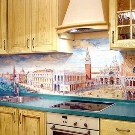
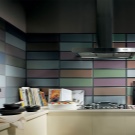
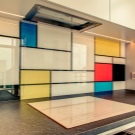
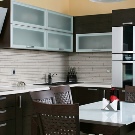
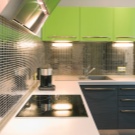
Popular brands
Today, many companies are engaged in the production of tile cladding. Among them, several manufacturers can be noted, whose products are in special demand among buyers.
- Porcelanosa - A manufacturer that produces collection tiles in restrained colors, suitable for the stylistics of classic branches of interior design, hi-tech, modern and minimalism. The products are characterized by discreet beauty, have a matte and polished surface type, imitates a malt mosaic, marble, and the structure of porous materials.
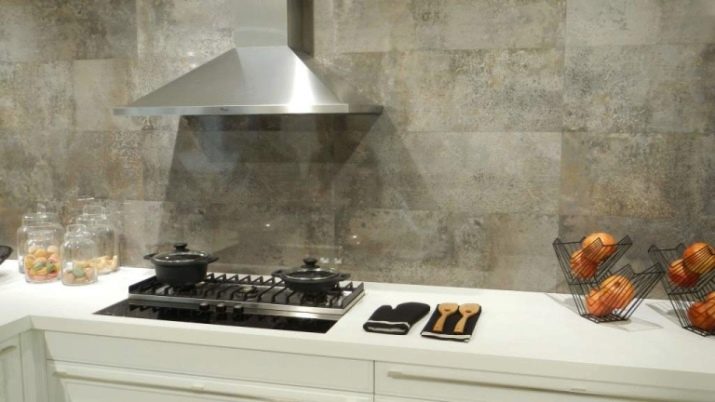
- Ape ceramica - A brand that produces tiles for different interior styles: urban (with urban theme inserts), a gastronomic print (for a country style), a pattern that is characteristic of the English style (stripes, lilies, geometry). In the lineup there is a tilt under the guise of reproductions of impressionists, lining with Spanish ornaments suitable for ethnic stylistics.
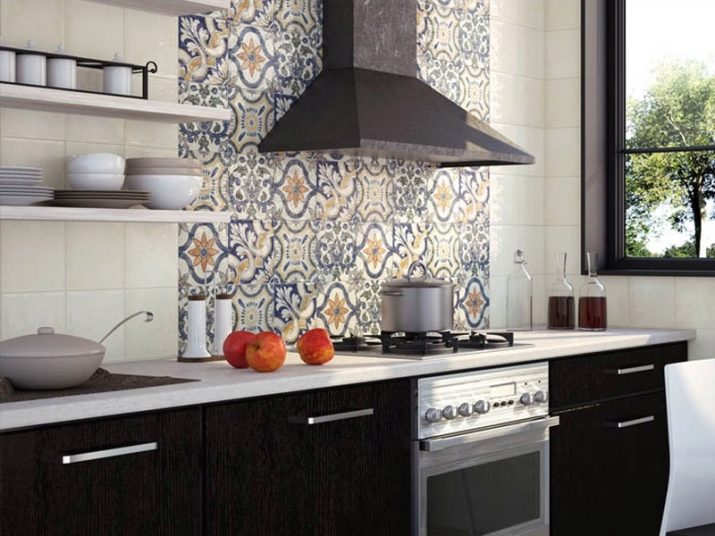
- Aparici - A brand that currently produces 50 different collections for every taste. Among them there are elements of a corrugated type with a non-standard decor, relief ornaments, gilding, prints in the form of photographs. The range is designed for such areas of interior design as minimalism, ethno, modern, baroque, classic, retro.
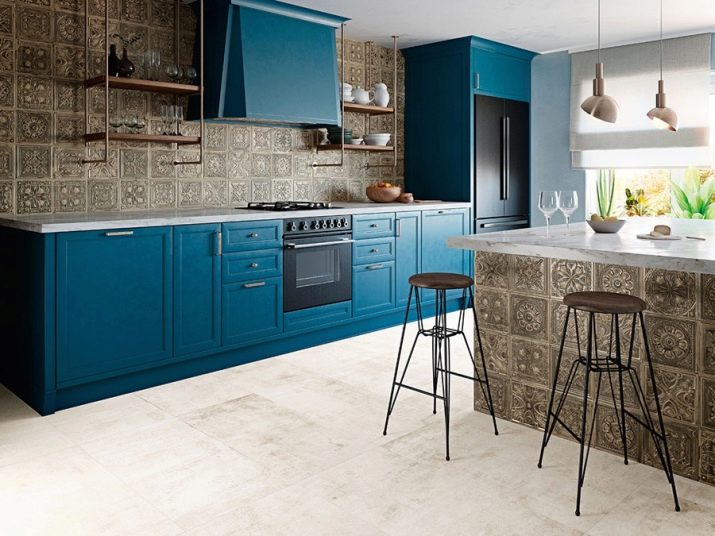
- Pamesa - A company that produces its collections in different variations of color schemes and drawings.Compared to the manufacturers of its segment, it is distinguished by the technology of short firing of ceramics. Some of the best collections include items with pink buds, floral prints, and heart-shaped, crescent moon, star-shaped décor. Manufacturer products are of the highest quality and color purity.
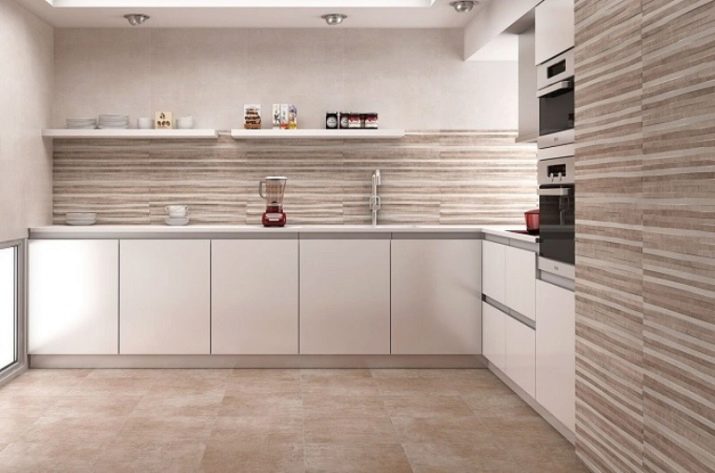
- Keramin - A manufacturer of high-quality ceramic glazed tiles, featuring a wide selection of textures and formats. Tiles of the brand are equipped with flooring and a variety of decorative elements. It can have a matte, glossy type of surface, it can be smooth or structured. Successfully imitates the texture of stone, metal, textile, concrete, wood.
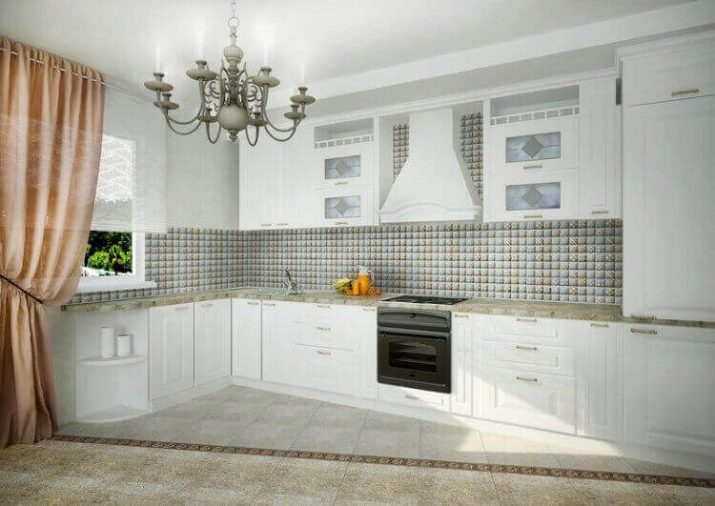
Masonry Methods
You can lay tiles on the apron in various ways.
- Classic there is nothing more than laying square elements of the same size and geometry with the formation of crosshairs. The design can be beaten by inserts of tile panels, using decorative details with a pattern, a print for chess.
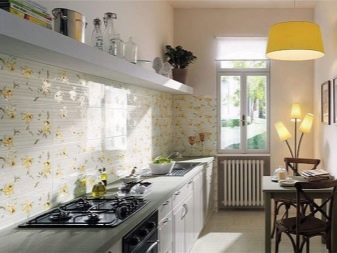
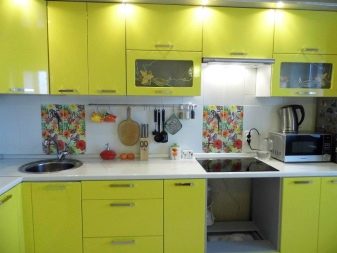
- Brick differs from the standard classics only in shape: the details are rectangular. Such a tile looks very appropriate in the interior of a loft style; for its embodiment, both smooth and even elements and relief porous are used.
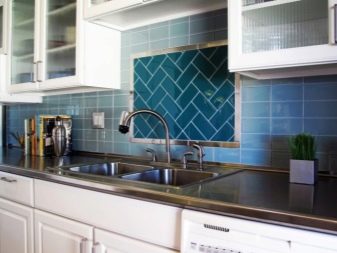
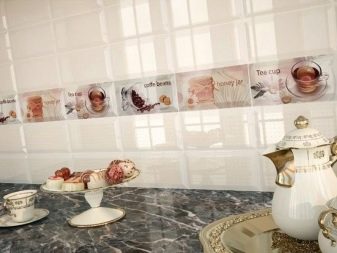
- Classics with shift or "wild boar" represents a laying of square plates, each subsequent row of which is shifted approximately to the middle of the width of the fragments of the previous one. According to this scheme, rectangular fragments of the cladding are also laid.
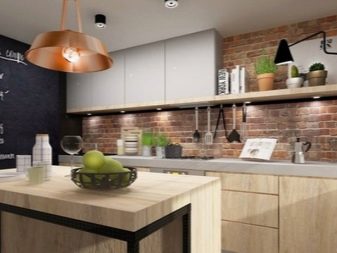
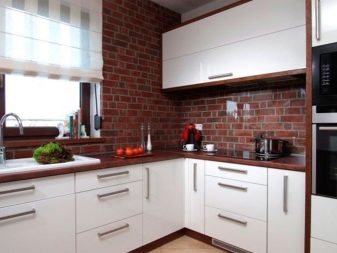
- Vertical masonry can be performed on the principle of a classic with a shift. Moreover, the shape of the elements can be used both square and rectangular. The appearance of such an apron is non-standard, for the desired effect using a single-color tile.

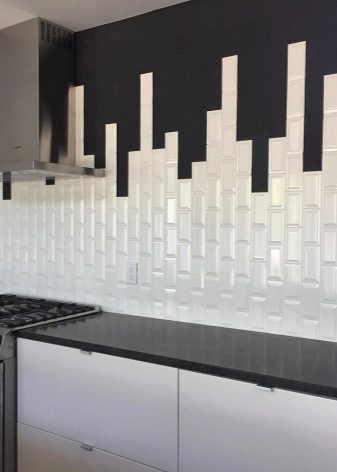
- Diagonal allows you to bring a fresh look into the interior of the kitchen, it looks interesting, is a laying of square plates at an angle of 45 degrees. According to the same scheme, lining with bricks with a shift is performed. The method is considered time-consuming, in addition, with such a facing more material is required and more trim is required.
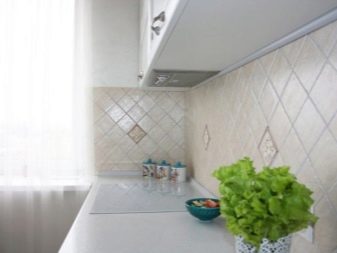

- Honeycombs obtained when laying hexagonal tiles. In this case, it is extremely important to observe the ideal geometry, since even 1 mm of mismatch of the seam will spoil the appearance of the finished lining. Today, this installation is considered one of the best suitable for lining aprons of modern kitchens.
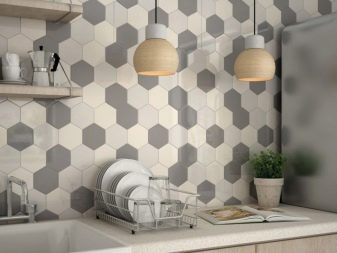
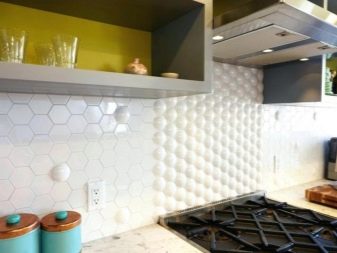
- "Christmas tree" differs from previous schemes in that it is laid out at an angle of 45 degrees with alternating the direction of the tiles left and right. At the same time, they need to be laid one on top of the other so that together they form the so-called Christmas tree. Laying of this type looks original, the elements can be laid not only diagonally, but also on the principle of vertical-horizontal.
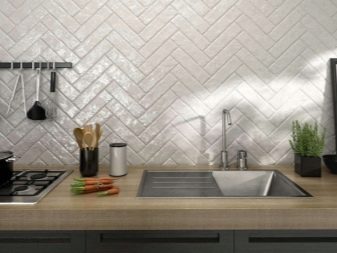
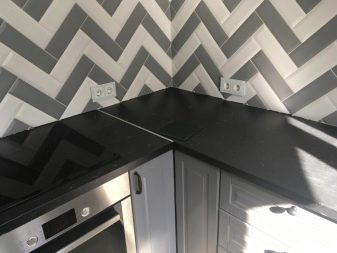
Choosing this or that type of facing, you have to rely on the shape of the tile, its size and the experience of the master.
Therefore, it is impossible to say unequivocally that it is better: even a laconic classic has every chance to look super-effective if it is selected and arranged in accordance with all the rules of style.
Selection recommendations
Having decided on the color, shape and type of facing material, you can go to the store to buy the desired tile. To really choose what you want, it is worth paying attention to several criteria for a good purchase.
- To get started, draw a sketchy sketch of the future apron. This will allow you to understand how it will look in the interior of a particular kitchen.
- According to the scheme, note the number of parts that will be needed for laying. Add 10-15% to the total number of fragments in case the material breaks on the road or is damaged during installation.
- If small objects are in sight in the kitchen, the preference when choosing should be given to monophonic elements. The patchwork is appropriate in combination with plain facades of the headset.
- You need to buy tiles from one batch, since different shades may vary in different series.Against the general background, this can be noticeable.
- If the cladding is selected according to the color of any accessory, at home it is worth picking a little thing in the desired color. The color of the material on the display case is usually different, so you can choose exactly what you need.
- Inspect each tile for geometry upon purchase. If the material is curved or of a different thickness, it cannot be glued evenly.
- If possible, it is better to select elements with a protective layer or marking A, AA. They are more resistant to chemicals during harvesting.
- You need to select the drawings correctly: they must be not only beautiful, but also appropriate in one or another style.
- Never take the leftovers: they can appear from several parties with visual discrepancy of color (it is money down the drain).
- When choosing paired ceramics, give preference to a companion tile. She has identical geometry and size.
- If practicality is important to you, the white color of the material, depending on the color of the furniture, can be replaced with another (beige, pistachio, light gray).

Tips
When buying tiles for a kitchen apron, it is advisable to immediately get a good glue and grout. As for the grout mixture, it is more advisable to purchase a finished colored product, the tone of which you can pick up while more accurately buying. If you think it’s better to take the white mixture and color it yourself, varying the degree of color saturation, Do not forget to choose a color.
The mixture, like glue, must be taken "fresh", and therefore it is necessary to pay attention to the release date of the products. The old grout is going into lumps that are difficult to mix, and even more so evenly connected to the color. It is able to spoil the appearance of a well-laid apron. In order to extend durability the finished apron should be sprayed with a special tool that protects the seams.
When choosing this or that option it is worth taking a note: the smaller the area of the kitchen, the smaller the size of the plates and the less noticeable grout.
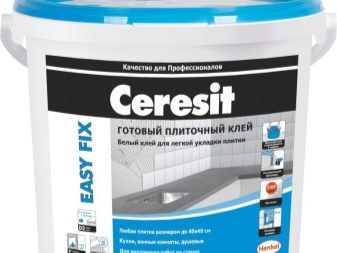
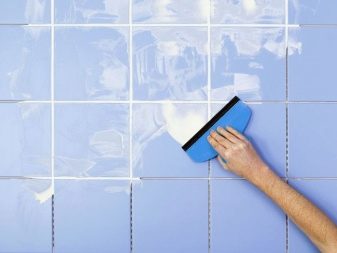
Contrasting color seams can add a lot of lines to the interior, which is extremely undesirable for the interior composition. In small kitchens, it is impossible to zone the space with a mosaic, which looks better in the form of a “kaleidoscope” laying from afar.
As for the ideal color for a white kitchen, here the preference when choosing a lining can be given to different colors: wood, pistachio or metallic. You need to choose a color in such a way that it is comfortable for all households. For example, pink and fuchsia at a subconscious level cause discomfort among the stronger sex. Blue, when there is a lot of it, causes depression, black depresses without dosage, red - excites and provokes aggression.
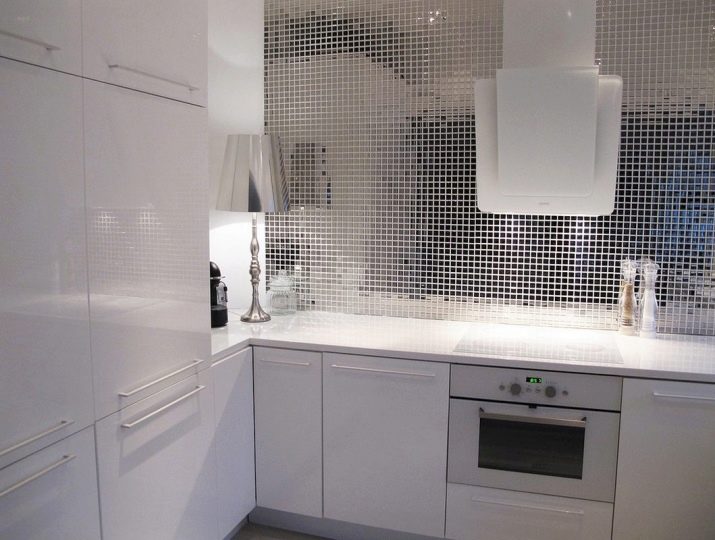
When laying, you can show imagination by choosing the cladding option by combining plates of different sizes and shapes. For example, the main part of the apron can be laid out in the usual way, and its central part - with the addition of mosaic elements in a contrasting color. It is possible to frame a panel on an apron with a border or a mosaic. Someone beats the styling, focusing on the use of contrasting tile fragments.


Good examples
We offer 10 original ideas for decorating a kitchen with an apron made of tiles.
- Emphasizing the workspace by decorating the wall with long white tiles.
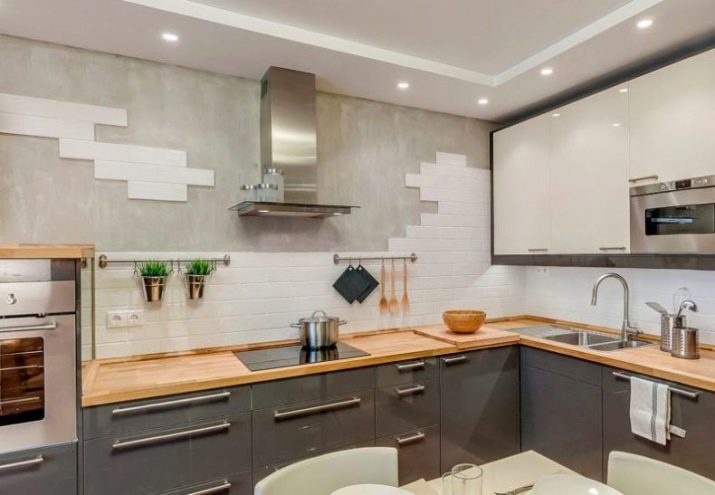
- Laying tiles with an offset or a spacing successfully fits into the interior of a classic kitchen.
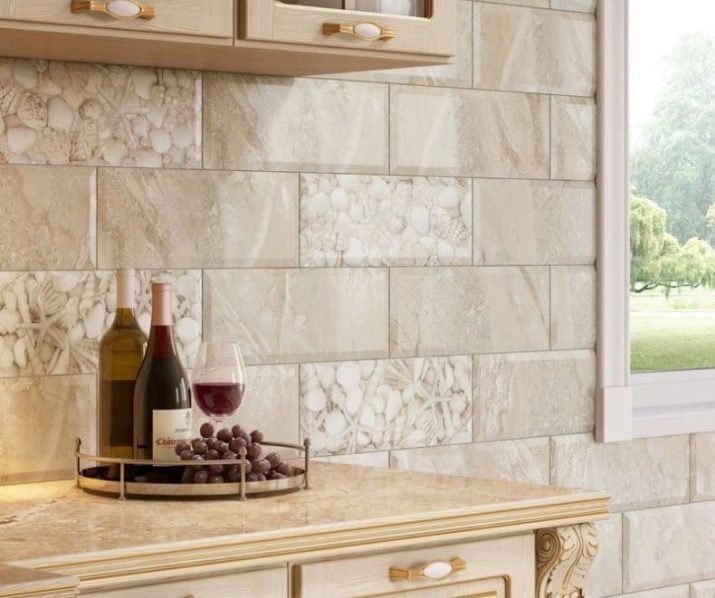
- Dressing the working area under the apron with large tiles with embossed trim, decorated with gilding.
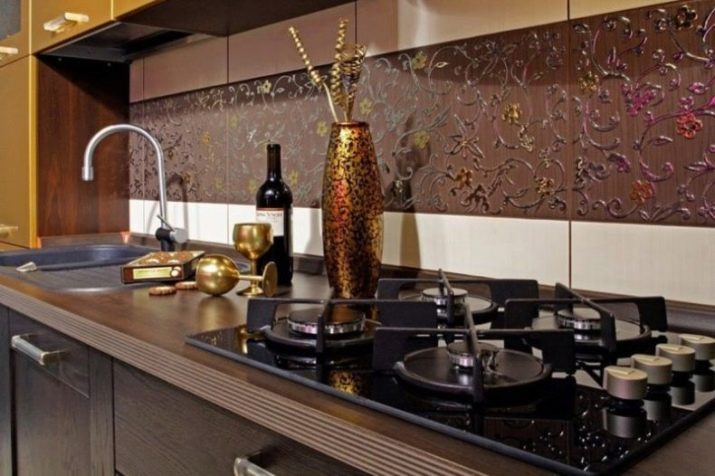
- An example of emphasizing the central part of the kitchen apron by means of a tile panel.

- Using mosaics to decorate the accent of the working area of the kitchen.
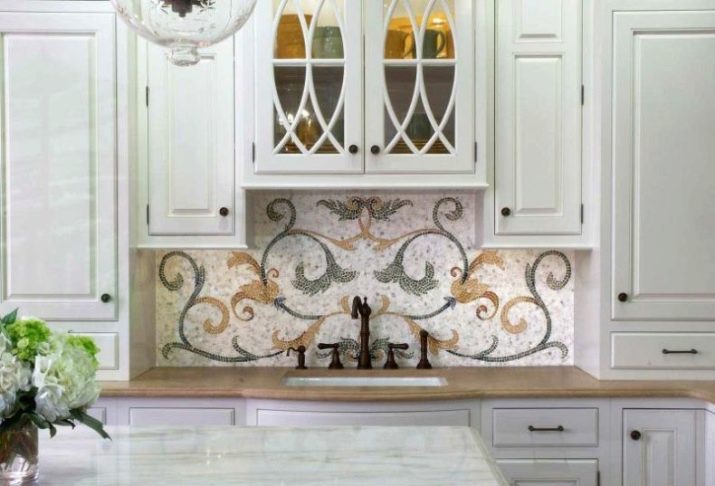
- An example of decorating the workspace above the stove with a spectacular panel with arched trim.

- The use of multi-colored tiles in bright colors in combination with the white color of the kitchen unit.
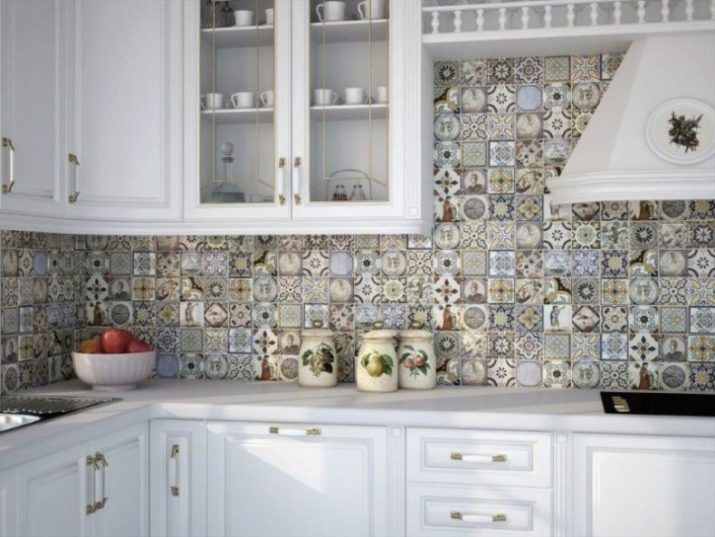
- Diagonal cladding with a pattern in the form of openwork rhombuses made of serial tiles.
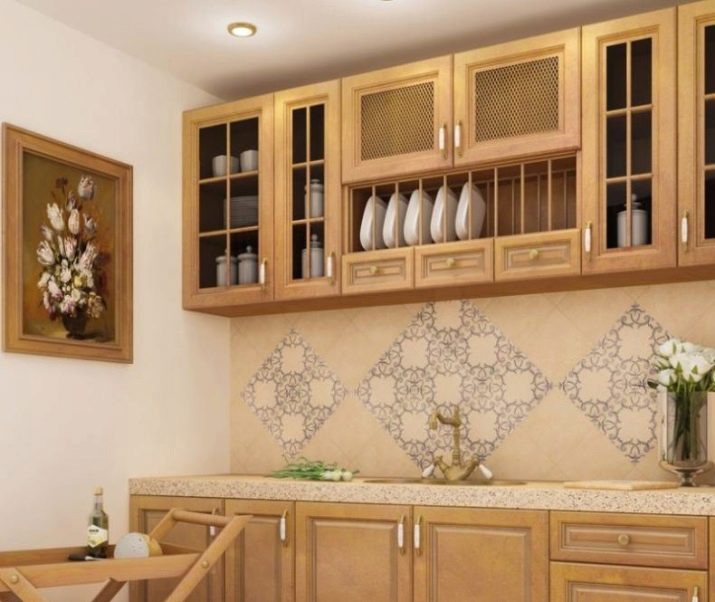
- Variant of finishing an apron in the washing area, made in the spirit of country traditions.
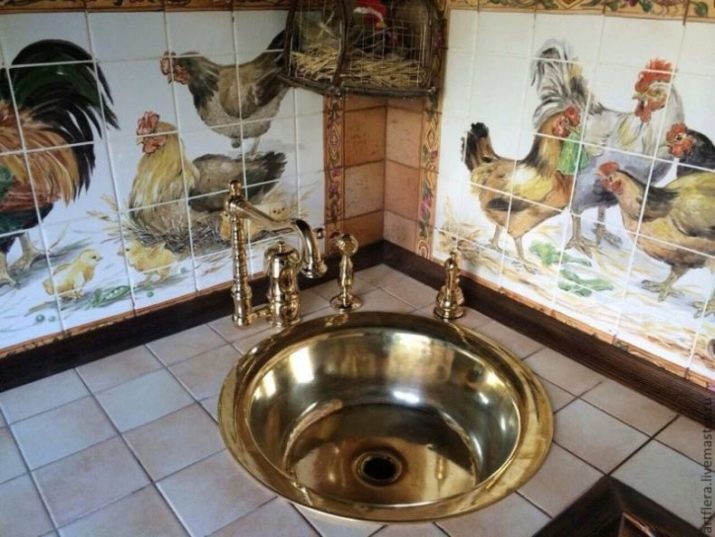
- An example of harmonious selection of tiles in the interior of a neutral kitchen.
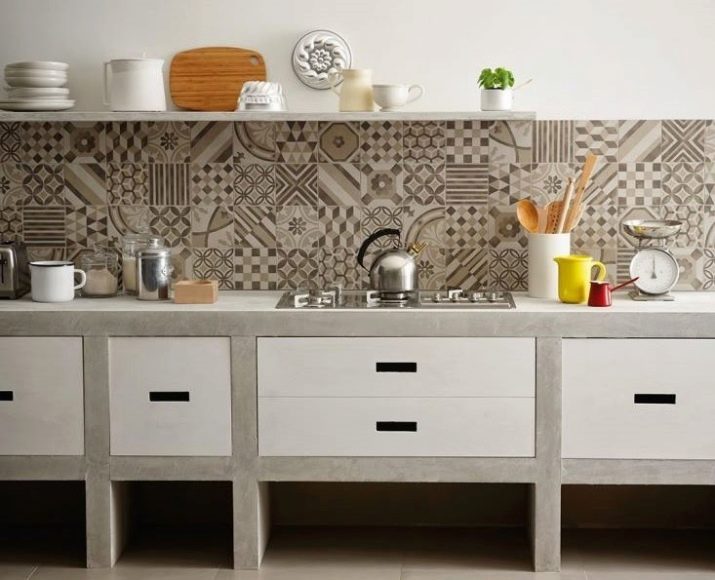
An overview of the aprons in the kitchen is shown in the video below.
